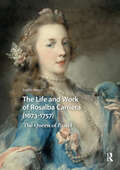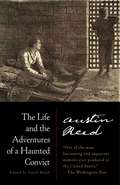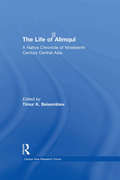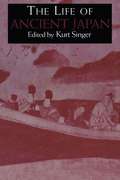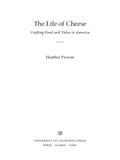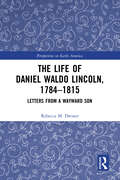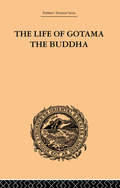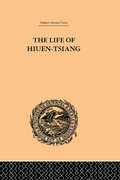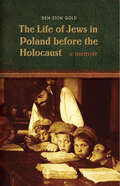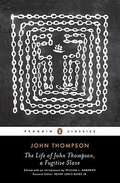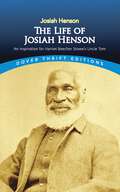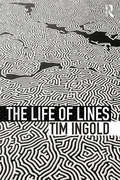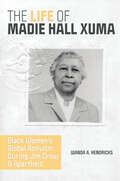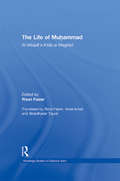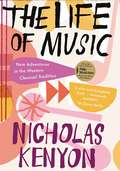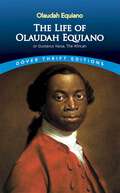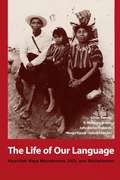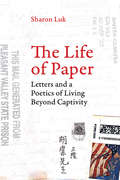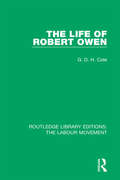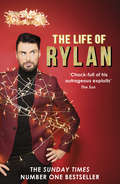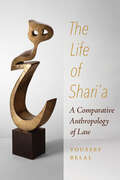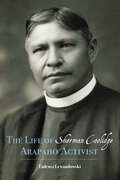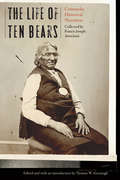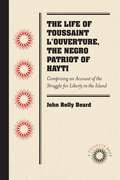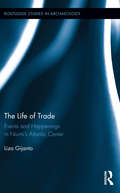- Table View
- List View
The Life and Work of Rosalba Carriera: The Queen of Pastel (Visual and Material Culture, 1300-1700)
by Angela ObererThe Life and Work of Rosalba Carriera (1673-1757): The Queen of Pastel is the first extensive biographical narrative in English of Rosalba Carriera. It is also the first scholarly investigation of the external and internal factors that helped to create this female painter's unique career in eighteenth-century Europe. It documents the difficulties, complications, and consequences that arose then -- and can also arise today -- when a woman decides to become an independent artist. This book contributes a new, in-depth analysis of the interplay between society's expectations, generally accepted codices for gendered behaviour, and one single female painter's astute strategies for achieving success, as well as autonomy in her professional life as a famed artist. Some of the questions that the author raises are: How did Carriera manage to build up her career? How did she run her business and organize her own workshop? What kind of artist was Carriera? Finally, what do her self-portraits reveal in terms of self-enactment and possibly autobiographical turning points?
The Life and the Adventures of a Haunted Convict
by David W. Blight Robert B. Stepto Caleb Smith Austin ReedThe earliest known prison memoir by an African American writer--recently discovered and authenticated by a team of Yale scholars--sheds light on the longstanding connection between race and incarceration in America. In 2009, scholars at Yale University came across a startling manuscript: the memoir of Austin Reed, a free black man born in the 1820s who spent most of his early life ricocheting between forced labor in prison and forced labor as an indentured servant. Lost for more than one hundred and fifty years, the handwritten document is the first known prison memoir written by an African American. Corroborated by prison records and other documentary sources, Reed's text gives a gripping first-person account of an antebellum Northern life lived outside slavery that nonetheless bore, in its day-to-day details, unsettling resemblances to that very institution. Now, for the first time, we can hear Austin Reed's story as he meant to tell it. He was born to a middle-class black family in the boomtown of Rochester, New York, but when his father died, his mother struggled to make ends meet. Still a child, Reed was placed as an indentured servant to a nearby family of white farmers near Rochester. He was caught attempting to set fire to a building and sentenced to ten years at Manhattan's brutal House of Refuge, an early juvenile reformatory that would soon become known for beatings and forced labor. Seven years later, Reed found himself at New York's infamous Auburn State Prison. It was there that he finished writing this memoir, which explores America's first reformatory and first industrial prison from an inmate's point of view, recalling the great cruelties and kindnesses he experienced in those places and excavating patterns of racial segregation, exploitation, and bondage that extended beyond the boundaries of the slaveholding South, into free New York. Accompanied by fascinating historical documents (including a series of poignant letters written by Reed near the end of his life), The Life and the Adventures of a Haunted Convict is a work of uncommon beauty that tells a story of nineteenth-century racism, violence, labor, and captivity in a proud, defiant voice. Reed's memoir illuminates his own life and times--as well as ours today.Advance praise for The Life and the Adventures of a Haunted Convict "This extraordinary first-person account, from New York's House of Refuge to the Auburn State Prison, exposes the roots of a prison culture that continues to haunt far too many black families today. We owe a great debt to Austin Reed for writing it and to Caleb Smith for unraveling the mysteries of identity and authentication after its discovery a century-and-a-half later."--Henry Louis Gates, Jr., Alphonse Fletcher University Professor, Harvard University "The discovery story behind this memoir by a black prisoner--written 150 years ago and hidden for generations--is a modern gumshoe plot, and the tale it tells of perennial jail for the crime of blackness reads like a case study from today's age of mass incarceration."--Edward Ball, author of the National Book Award winner Slaves in the Family"The voice of Austin Reed, a black man in early nineteenth-century America who was incarcerated at the tender age of ten, rises up and speaks to us now, in artful, picaresque tones, to tell of his own unbelievable suffering. He's a riveting figure."--Rachel Kushner, author of The Flamethrowers"A moving, significant narrative that affords both an elegantly produced glimpse of nineteenth-century prison life and a new chapter in African-American history."--Kirkus ReviewsFrom the Hardcover edition.
The Life of Alimqul: A Native Chronicle of Nineteenth Century Central Asia (Central Asia Research Forum)
by Timur BeisembievThis work studies a narrative devoted to the history of the Kokand Khanate, a state that played a great role in Central Asian history in the 18th and 19th centuries, controlling territory equal to continental western Europe, until it was conquered by the Russian Empire in 1876. This unique manuscript, discovered by the editor in Tashkent, is a biography of Alimqul Amir-i Lashkar, Commander-in- Chief of the Kokand army and de facto ruler of the Kokand state in 1863-1865, who died in battle at the age of thirty three. Shortly after his death, Tashkent was captured by Russian troops. The author of this biography was an intimate friend of Alimqul and was actively involved in politics. Includes rare reproduction of Chagatay Turkic text.
The Life of Ancient Japan: Selected Contemporary Texts Illustrating Social Life and Ideals before the Era of Seclusion (Japan Library Classic Paperback Ser.)
by Kurt SingerFirst Published in 2002. Routledge is an imprint of Taylor & Francis, an informa company.
The Life of Cheese: Crafting Food and Value in America
by Heather PaxsonCheese is alive, and alive with meaning. Heather Paxson's beautifully written anthropological study of American artisanal cheesemaking tells the story of how craftwork has become a new source of cultural and economic value for producers as well as consumers. Dairy farmers and artisans inhabit a world in which their colleagues and collaborators are a wild cast of characters, including plants, animals, microorganisms, family members, employees, and customers. As "unfinished" commodities, living products whose qualities are not fully settled, handmade cheeses embody a mix of new and old ideas about taste and value. By exploring the life of cheese, Paxson helps rethink the politics of food, land, and labor today.
The Life of Daniel Waldo Lincoln, 1784-1815: Letters from a Wayward Son (Perspectives on Early America)
by Rebecca M. DresserPlaced within a comprehensive contextual historical narrative, The Life of Daniel Waldo Lincoln, 1784–1815 offers a compelling portrait of one brilliant but compromised man’s perspective of his changing times. Daniel Waldo Lincoln, the second son of Levi Lincoln, a prominent Massachusetts Democratic-Republican, was destined to become a man of influence. Born in 1784, equipped with wealth, prestige, a Harvard education, powerful friends, and a distinguished family name, Lincoln ranked high among the inheritors of the Revolution whose purpose was to protect the ideals of the nation’s founders. In over 250 private letters, essays, and poems beginning with his first day at Harvard in 1801 and ending just weeks before his death in 1815, Lincoln brings to readers a portrait of privilege as it careened into disappointment. A young man active in Republican circles, an orator and attorney in Worcester, Portland, Maine, and Boston, Lincoln comments on the politics, honor, religion, the War of 1812, and his struggles with romance and alcohol. Written for private eyes, his letters are an unusually candid eyewitness account of early-nineteenth-century Massachusetts interwoven with his personal agonies. This volume is of great use for students and scholars interested in life, society, and politics in nineteenth-century America.
The Life of Gotama the Buddha: Compiled exclusively from the Pali Canon
by E.H. BrewsterFirst Published in 2000. Routledge is an imprint of Taylor & Francis, an informa company.
The Life of Hiuen-Tsiang (Trubner's Oriental Ser.)
by Samuel BealFirst Published in 2000. Routledge is an imprint of Taylor & Francis, an informa company.
The Life of Jews in Poland before the Holocaust: A Memoir
by Ben-Zion GoldBen-Zion Gold&’s memoir brings to life the world of a million Jews in pre-World War II Poland who were later destroyed by the Nazis. Warmly recalling the relationships, rituals, observances, and celebrations, Gold evokes the sense of family and faith that helped him through the catastrophe that followed. With him we experience the life and institutions of the time: the Heder and hooky playing, his encounter with Hassidism, the courtship and marriage of his oldest sister, and the author&’s own first inkling of love. And with him, we recapture the memories that made life worth living in the face of disaster, along with the experience of the human capacity for evil that tested and transformed his faith as it devastated his world. Finally, Gold tells of the fate of his family and of his own escape from that fate.
The Life of John Thompson, a Fugitive Slave
by John ThompsonThe unique narrative of a slave who fled to freedom and sailed aboard a whaling vessel. John Thompson was born into slavery on a Maryland plantation in 1812. Originally published in 1856, The Life of John Thompson, a Fugitive Slave chronicles his enslavement, his escape, and his life in the North, where he lived as a free man until fear of recapture drove him to flee once again-this time to sea aboard the Milwood, a whaling vessel. The only fugitive slave narrator to report a whaling voyage, Thompson crafted from his seafaring experience an allegorical sermon that caps his Life and renders it a kind of African American Pilgrim's Progress, as well as a narrative of struggle with, escape from, and triumph over American slavery. .
The Life of Josiah Henson: An Inspiration for Harriet Beecher Stowe's Uncle Tom (Travel In America Series)
by Josiah HensonBorn into slavery on a Maryland farm, Josiah Henson (1789–1883) worked as a foreman, married, and became a preacher in the Methodist Episcopal Church. Faced with the prospect of separation from his family, Henson fled with his wife and children to Ontario, where he became a leader in the Afro-Canadian community. The Life of Josiah Henson, Formerly a Slave, Now an Inhabitant of Canada, as Narrated by Himself first appeared in 1849. The book's avid readers included Harriet Beecher Stowe, who later acknowledged its influence on her own masterwork, Uncle Tom's Cabin.Henson's narrative recounts the circumstances of his bondage, his conversion to Christianity, and his fruitless attempts to buy his freedom. Risking starvation, exposure, and recapture, the Henson family walked from Kentucky to Ohio. Native Americans assisted the struggling family, as did sympathetic boatmen who ferried them across Lake Erie. Safely established as a tenant farmer and clergyman in a new country, Henson took an active role in organizing a self-sufficient community. His memoirs helped alert his contemporaries to the horrors and heartbreak of slavery, and they offer modern readers an authentic account of one family's triumph over injustice and inhumanity.
The Life of Lines
by Tim IngoldTo live, every being must put out a line, and in life these lines tangle with one another. This book is a study of the life of lines. Following on from Tim Ingold's groundbreaking work Lines: A Brief History, it offers a wholly original series of meditations on life, ground, weather, walking, imagination and what it means to be human. In the first part, Ingold argues that a world of life is woven from knots, and not built from blocks as commonly thought. He shows how the principle of knotting underwrites both the way things join with one another, in walls, buildings and bodies, and the composition of the ground and the knowledge we find there. In the second part, Ingold argues that to study living lines, we must also study the weather. To complement a linealogy that asks what is common to walking, weaving, observing, singing, storytelling and writing, he develops a meteorology that seeks the common denominator of breath, time, mood, sound, memory, colour and the sky. This denominator is the atmosphere. In the third part, Ingold carries the line into the domain of human life. He shows that for life to continue, the things we do must be framed within the lives we undergo. In continually answering to one another, these lives enact a principle of correspondence that is fundamentally social. This compelling volume brings our thinking about the material world refreshingly back to life. While anchored in anthropology, the book ranges widely over an interdisciplinary terrain that includes philosophy, geography, sociology, art and architecture.
The Life of Madie Hall Xuma: Black Women's Global Activism during Jim Crow and Apartheid (Women, Gender, and Sexuality in American History)
by Wanda A. HendricksRevered in South Africa as "An African American Mother of the Nation," Madie Beatrice Hall Xuma spent her extraordinary life immersed in global women's activism. Wanda A. Hendricks's biography follows Hall Xuma from her upbringing in the Jim Crow South to her leadership role in the African National Congress (ANC) and beyond. Hall Xuma was already known for her social welfare work when she married South African physician and ANC activist Alfred Bitini Xuma. Becoming president of the ANC Women’s League put Hall Xuma at the forefront of fighting racial discrimination as South Africa moved toward apartheid. Hendricks provides the long-overlooked context for the events that undergirded Hall Xuma’s life and work. As she shows, a confluence of history, ideas, and organizations both shaped Hall Xuma and centered her in the histories of Black women and women’s activism, and of South Africa and the United States.
The Life of Muhammad: Al-Waqidi's Kitab al-Maghazi
by Rizwi FaizerMuhammad b. ‘Umar al-Waqidi was a Muslim scholar, born in Medina in the 1st Century. Of his several writings the most significant is the Kitab al-Maghazi, one of the earliest standard histories of the life of the Prophet. Translated into English for the first time, Rizwi Faizer makes available this key text to a new, English-speaking audience. It includes an "Introduction" authored jointly by Rizwi Faizer and Andrew Rippin and a carefully prepared index. The book deals with the events of the Prophet’s life from the time of his emigration from Mecca to his death, and is generally considered to be biographical. Bringing together events in the Prophet’s life with appropriate passages of Qur’an in a considered sequence, the author presents an interpretation of Islam that existed in his times. It includes citations from the Qur’ān, as well as poetry that appears to have been inspired by activities during his life. This English translation of a seminal text on the life of Muhammad is an invaluable addition to the existing literature, and will be of great significance to students and scholars in the field of Islamic studies, Islamic history, Medieval history and Arabic literature.
The Life of Music: New Adventures in the Western Classical Tradition
by Nicholas KenyonNicholas Kenyon explores the enduring appeal of the classical canon at a moment when we can access all music—across time and cultures&“At its lively best when Kenyon&’s own passions are laid bare, . . . his belief, above all, in the power of music to unite individual and community.&”—Fiona Maddocks, The Observer Immersed in music for much of his life as writer, broadcaster and concert presenter, former director of the BBC Proms, Nicholas Kenyon has long championed an astonishingly wide range of composers and performers. Now, as we think about culture in fresh ways, Kenyon revisits the stories that make up the classical tradition and foregrounds those which are too often overlooked. This inclusive, knowledgeable, and enthusiastic guide highlights the achievements of the women and men, amateurs and professionals, who bring music to life. Taking us from pianist Myra Hess&’s performance in London during the Blitz, to John Adams&’s composition of a piece for mourners after New York&’s 9/11 attacks, to Italian opera singers singing from their balconies amidst the 2020 pandemic, Kenyon shows that no matter how great the crisis, music has the power to bring us together. His personal, celebratory account transforms our understanding of how classical music is made—and shows us why it is more relevant than ever.
The Life of Olaudah Equiano: Large Print (Dover Thrift Editions Ser.)
by Olaudah EquianoCompelling work traces the formidable journey of an Igbo prince from captivity to freedom and literacy and recounts his enslavement in the New World, service in the Seven Years War with General Wolfe in Canada, voyages to the Arctic with the Phipps expedition of 1772-73, six months among the Miskito Indians in Central America, and a grand tour of the Mediterranean as a personal servant to an English gentlemen. Skillfully written, with a wealth of engrossing detail, this powerful narrative deftly illustrates the nature of the black experience in slavery.
The Life of Our Language: Kaqchikel Maya Maintenance, Shift, and Revitalization
by Susan Garzon R. Mckenna BrownThe native Maya peoples of Mexico, Guatemala, Honduras, and Belize have been remarkably successful in maintaining their cultural identity during centuries of contact with and domination by outside groups. <P><P>Yet change is occurring in all Mayan communities as contact with Spanish-speaking Ladino society increases. This book explores change and continuity in one of the most vital areas of Mayan culture--language use. <P> The authors look specifically at Kaqchikel, one of the most commonly spoken Mayan languages. Following an examination of language contact situations among indigenous groups in the Americas, the authors proceed to a historical overview of the use of Kaqchikel in the Guatemalan Highlands. They then present case studies of three highland communities in which the balance is shifting between Kaqchikel and Spanish. Wuqu' Ajpub', a native Kaqchikel speaker, gives a personal account of growing up negotiating between the two languages and the different world views they encode. The authors conclude with a look at the Mayan language revitalization movement and offer a scenario in which Kaqchikel and other Mayan languages can continue to thrive.
The Life of Paper: Letters and a Poetics of Living Beyond Captivity
by Sharon LukThe Life of Paper offers a wholly original and inspiring analysis of how people facing systematic social dismantling have engaged letter correspondence to remake themselves—from bodily integrity to subjectivity and collective and spiritual being. Exploring the evolution of racism and confinement in California history, this ambitious investigation disrupts common understandings of the early detention of Chinese migrants (1880s–1920s), the internment of Japanese Americans (1930s–1940s), and the mass incarceration of African Americans (1960s–present) in its meditation on modern development and imprisonment as a way of life. Situating letters within global capitalist movements, racial logics, and overlapping modes of social control, Sharon Luk demonstrates how correspondence becomes a poetic act of reinvention and a way to live for those who are incarcerated.
The Life of Robert Owen (Routledge Library Editions: The Labour Movement #11)
by G. D. ColeFirst published in 1925. Robert Owen was, in the author’s words, ‘that rarest of phenomena, an utterly disinterested critic of a system by which he had himself risen to greatness’, and in studying his life this work reveals with a remarkable clarity the first phases of the Industrial Revolution crowded as it was with events, changes, ideas, and characters. This title will be of great interest to scholars and students of labour history.
The Life of Rylan
by Rylan Clark-Neal*The Sunday Times Number One Bestseller*Well hark at you, stumbling upon my autobiography. Bet you wouldn't have put money on that three years ago, eh?! Please don't stress yourself out too much, though, it's actually socially acceptable nowadays that you're interested. Firstly I'd like to emphasise that I have WRITTEN THIS BOOK MYSELF, so be assured you're getting the TOOTH, the WHOLE TOOTH and NOTHING BUT THE TOOTH! (Which was my original choice of title, but babe, we're so over that.) This book documents my story, year by year, from my humble beginnings growing up in the East End of London, becoming one of the nation's most talked-about people overnight to finally moving up the spectrum from guilty pleasure, and getting nearer to national treasure.It will make you laugh, cry, and most importantly you'll discover who I really am. If it doesn't do any of those things you're not legally entitled to a refund - just clearing that up ;-).I hope you enjoy reading this book as much as I have enjoyed writing it. This book has been like therapy, and LORD was I in need. Enjoy!
The Life of Shari'a: A Comparative Anthropology of Law
by Youssef BelalIs there a way to think about contemporary life with knowledge that is neither modern nor Western? Rather than confining Islam to a "religion" and shariʿa to its "law," Youssef Belal provocatively argues that Islamic shariʿa is a mode of knowledge with its own concepts and scholarly categories through which the world and the self are grasped. The Life of Shariʿa considers two intertwined lineages: how Islamic scholars have formulated knowledge from the classical period to today and how Westerners have understood the law and its origins. By melding these two traditions, Belal puts the formation of modern law under a new light and offers, through a compelling conceptualization of shariʿa, a powerful argument for its continued relevance to the life of contemporary Muslims.
The Life of Sherman Coolidge, Arapaho Activist
by Dr. Tadeusz LewandowskiSherman Coolidge&’s (1860–1932) panoramic life as survivor of the Indian Wars, witness to the maladministration of the reservation system, mediator between Native and white worlds, and ultimate defender of Native rights and heritage made him the embodiment of his era in American Indian history. Born to a band of Northern Arapaho in present-day Wyoming, Des-che-wa-wah (Runs On Top) endured a series of harrowing tragedies against the brutal backdrop of the nineteenth-century Indian Wars. As a boy he experienced the merciless killings of his family in vicious raids and attacks, surviving only to be given up by his starving mother to U.S. officers stationed at a western military base. Des-che-wa-wah was eventually adopted by a sympathetic infantry lieutenant who changed his name and set his life on a radically different course. Over the next sixty years Coolidge inhabited western plains and eastern cities, rode in military campaigns against the Lakota, entered the Episcopal priesthood, labored as missionary to his tribe on the Wind River Reservation, fomented dangerous conspiracies, married a wealthy New York heiress, met with presidents and congressmen, and became one of the nation&’s most prominent Indigenous persons as leader of the Native-run reform group the Society of American Indians. Coolidge&’s fascinating biography is essential for understanding the myriad ways Native Americans faced modernity at the turn of the century.
The Life of Ten Bears: Comanche Historical Narratives
by Francis Joseph Attocknie Thomas W. KavanaghThe Life of Ten Bears is a remarkable collection of nineteenth-century Comanche oral histories given by Francis Joseph “Joe A” Attocknie. Although various elements of Ten Bears’s life (ca. 1790–1872) are widely known, including several versions of how the toddler Ten Bears survived the massacre of his family, other parts have not been as widely publicized, remaining instead in the collective memory of his descendants. Other narratives in this collection reference lesser-known family members. These narratives are about the historical episodes that Attocknie’s family thought were worth remembering and add a unique perspective on Comanche society and tradition as experienced through several generations of his family. Kavanagh’s introduction adds context to the personal narratives by discussing the process of transmission. These narratives serve multiple purposes for Comanche families and communities. Some autobiographical accounts, “recounting” brave deeds and war honors, function as validation of status claims, while others illustrate the giving of names; still others recall humorous situations, song-ridicules, slapstick, and tragedies. Such family oral histories quickly transcend specific people and events by restoring key voices to the larger historical narrative of the American West.
The Life of Toussaint L'Ouverture, the Negro Patriot of Hayti
by John Relly BeardToussaint L'Ouverture (1743-1803) won international renown in the Haitian fight for independence. He led thousands of former slaves into battle against French, Spanish, and English forces, routing the Europeans and seizing control of the entire island of Hispaniola. L'Ouverture became governor and commander-in-chief of Haiti before officially acknowledging French rule in 1801, when he submitted a newly written constitution to Napoleon Bonaparte (1769-1821) and the French legislature for ratification. In response, Bonaparte sent an army to depose L'Ouverture, who was taken prisoner in June of 1802 and shipped to France, where he died of pneumonia in April 1803. The Life of Toussaint L'Ouverture (1853) was first published in London on the fiftieth anniversary of L'Ouverture's death and remained the authoritative English-language history of L'Ouverture's life until the late twentieth century. Throughout the text, John Relly Beard compares L'Ouverture to famously successful white generals, argues for his supremacy, and states that his ultimate failure to liberate Haiti and untimely death are the products of unfortunate circumstances--not an indictment of his character or leadership abilities.A DOCSOUTH BOOK. This collaboration between UNC Press and the University of North Carolina at Chapel Hill Library brings selected classic works from the digital library of Documenting the American South back into print. DocSouth Books uses the latest digital technologies to make these works available as downloadable e-books or print-on-demand publications. DocSouth Books are unaltered from the original publication, providing affordable and easily accessible editions to a new generation of scholars, students, and general readers.
The Life of Trade: Events and Happenings in the Niumi’s Atlantic Center (Routledge Studies in Archaeology)
by Liza GijantoThe Life of Trade utilizes archaeological and historical sources to address the dynamic nature of the Atlantic trade on the Gambia River. Taking a fresh multi-disciplinary approach, the book highlights the region’s atypical position as a commercial crossroads and access point for both interior and Atlantic markets. This engagement with a diversified commodities trade brought about the formation of a multi-ethnic, multi-religious community which was supported by, and reliant on, economic exchange. Gijanto situates the Niumi Kingdom within the emerging capitalist world-system through the analysis of data collected from archaeological excavations at four sites: the central multi-ethnic trading village of Juffure, the associated British merchant company factory there, and the two nearby settlements of San Domingo and Lamin Conco. As part of the Atlantic world, residents were in a continual process of negotiation between their local socio-economic structures and the commodities and ideas introduced by foreign traders. Gijanto sheds light on these interactions, exploring the impact of increased access to wealth by examining a number of excavated objects associated with public display, including European glass trading beads, faunal and botanical remains and locally produced ceramics. Presenting new perspectives on the complex nature of the Atlantic trade in the region The Life of Trade enriches our understanding of this period of great change in West Africa.
